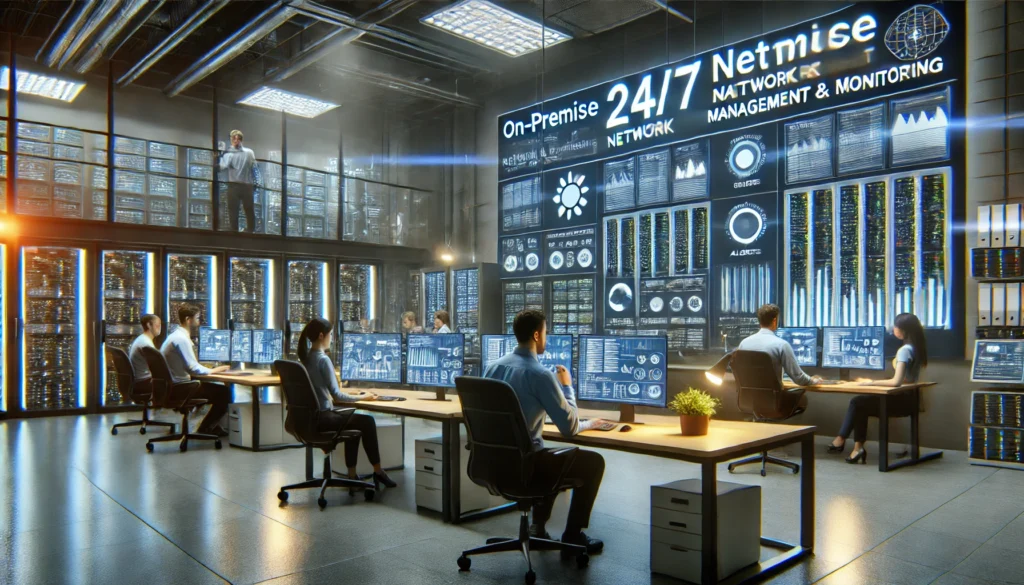That’s why on-premises 24/7 network management and monitoring have become as important to the business attempting to protect its network structure by using uninterrupted services. These days, businesses run on networks to make sure things work well in the office (or wherever you are working from), for communicating among employees booted up and at their desks or scattered around a city wide area network of some kind, managing data within your organization, basically all about productivity. . A single network outage, for example due to a security breach (hack), can result in losses of several million euros and put the image of an entire company at risk.
What is On-Premise 24/7 Network Management and Monitoring?
You could provide on-premise 24/7 network management and monitoring, what means continuous control over your company’s network that comes directly from a traditional computer-based architecture. On-premise systems mean that businesses own their networks, this will ensure they have a direct view and control. What is happening in those solutions. For example, packet monitoring for network performance issues or anomalies; responding to identify and fix any failure where traffic management is required as well as balancing the bandwidth across all existing links when enforcing security boundaries for the purpose of offering clients access around a firewall.
Thanks to his 24/7 monitoring, businesses can catch any potential issues as they happen often stopping downtime and security incidents before they even start. This enables the on-premise system to be more preventative and have less downtime, reducing risks.
Why is On-Premise 24/7 Network Monitoring Important?
Every single day, the dependency on digital infrastructure is increasing because of that constant network monitoring becomes essential.This situation is only getting worse with the increasing dependence on digital infrastructure and hence real-time network monitoring cannot be ignored.
Each day the digital infrastructure dependency is increasing which makes network monitoring Here are several reasons why on-premise 24/7 network management and monitoring is crucial:
1. Preventing Downtime
some of the industries such as finance, healthcare or e-commerce where each minute network is unavailable means business and money lost this synchronous replication mode to handle failures could have catastrophic impact on businesses. On-premise 24/7 monitoring can catch network anomalies such as bandwidth bottlenecks, hardware malfunctions or simple bugs your software does not recover from early on before they
2. Improving Network Security
Businesses encounter a massive number of hackers, malware and other vulnerabilities that can breach data in the most secure servers. Unifying monitoring for the best security even non-traditional, behavioral and application based through on-premise 24/7 to view Agents that monitor network communications with your host applications or appliances across geographies. Intrusion work stops only making all of intrusion a good configuration. It speeds up your response time and reliability of managing security incident as everything in the network can be controlled on-site fully.
3. Real-Time Problem Resolution
Every second counts when network failure occurs. With 24/7 on-premise network management, IT teams can respond in real time to any sort of trouble say a connectivity issue, hardware malfunction or software bug. When problems are addressed in real time, businesses can avoid prolonged down times and get back to operating normally much quicker.
4. Compliance and Data Control
Industries with tight compliance needs like healthcare (HIPAA) and finance (PCI-DSS), truly need to own their network data. Local management helps to keep confidential information in own sight of the company. This lowers the chances of regulatory non-compliance and keeps data privacy safe. Anyway, out of justice..
5. Customized Solutions
Companies are able to customize their network infrastructure by using on-premise network management. Custom designs that fit every need be it controlling access, monitoring network traffic or creating redundancy you name the requirement and on-premise systems are there to fulfill your needs.
Key Components of On-Premise 24/7 Network Management and Monitoring
1. Network Monitoring Tools
Network monitoring tools oversee network performance continuously and measure bandwidth usage, latency, uptime as well improve in traffic patterns. They can do this by providing the necessary tools for IT admins to see into network activity, spot inefficiencies and address potential issues before they become business disruptors.
2. Security Monitoring
With the increase in malware and network attacks, protecting networks is the first thing on a checklist. Firewalls, Intrusion Detection and Prevention Systems (IDPS), Antivirus Software are a few of the security monitoring tools that again secure your system from unauthorized access or even detect to identify any loop hole present in it.
3. Fault Management
Detecting, isolating and correcting network faults (e.g. hardware failures or connectivity issues) Fault and Issue. IT teams will be automatically alerted by advanced fault management systems when an issue is detected so that the identified problems can be rectified immediately.
4. Performance Optimization
The pillars of effective network management are not simply detecting problems but also maximizing the performance of your networks as well. This includes load balancing, artery assignment and control of advice traffic to meet the wants of analytical production applications.
5. Incident Response Systems
Quick incident response is crucial in case of a network breakdown or security violation. An on-premise monitoring system with 24/7 ability can sense the problems a bit early then, alert you there is trouble and present logs over problem history which helps IT team to understand where did things go wrong in order to act up quick.
Benefits of On-Premise 24/7 Network Monitoring
1. Increased Uptime
The constant monitoring of network systems ensures that potential problems are addressed before they result in downtime, thus maximizing system availability and keeping critical business functions operational.
2. Enhanced Security
24/7 on-premise monitoring helps detect and respond to threats rapidly as the IT team can stay in charge of their prepared security measures. With the system near at hand, it is easier to find out when an incident happened.
3. Cost Savings
Even if these systems require additional upfront cost for on-premise monitoring, it is still much cheaper from longer downtime periods and better securements to limited times of operations we can experience during cloud outages. Continuous real-time monitoring also reduces emergencies and maintenance.
4. Complete Control Over Data
Which makes an on-premise system essential. This keeps that all-import data in the org, lessening third-party risk and potential breaches. For companies that work with sensitive data on-premise systems are crucial, simply because it offers the most control. This protects vital information moving among organizations as it minimizes the chances of third party access and breaches.
Challenges of On-Premise 24/7 Network Monitoring
Benefits of 24/7 network management on-premise There are still challenges with the model that organizations will need to overcome. On-premise you will need to have hardware, software and IT personnel that are dedicated for the management and upkeep of it all. This might not be feasible for smaller companies who are already resource-strapped.
Expensive up-front cost Buying the required equipment, and employing specialized staff for on-premise monitoring results in very high initial costs. Scalability Unlike cloud systems, scaling with on-pram can be much more challenging/expensive (hardware upgrades/purchases).
Conclusion
On-premise 24/7 network management and monitoring is a necessary part of any robust business infrastructure in the modern era. On the other hand, it provides round-the-clock monitoring of network performance and improves security while reducing downtime risks and cyber-threats. While it may take some investment in technology and trained professionals, the long-term advantages of having greater reliability, security control make tape an essential solution for any business managing data continuity.

